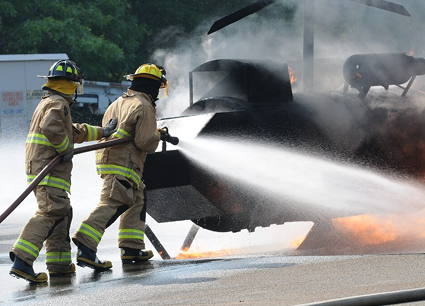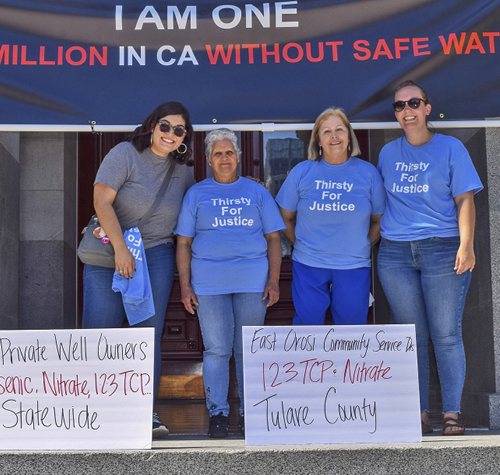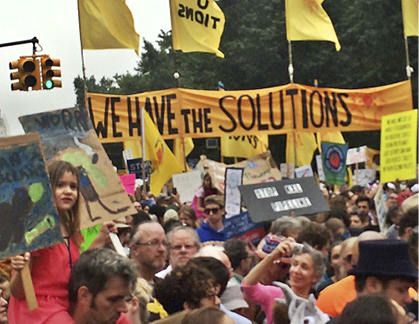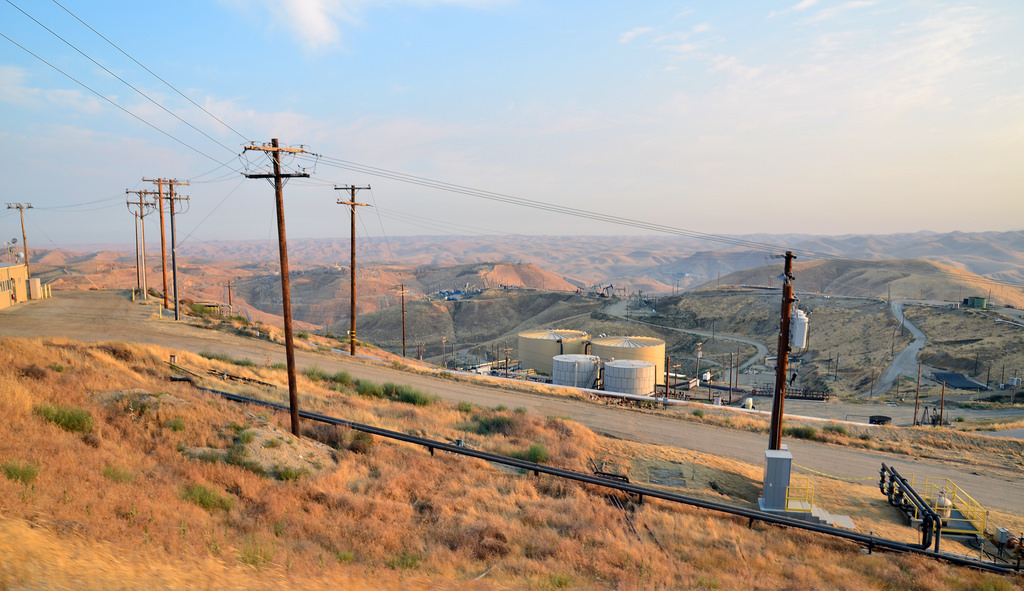In This Issue
- California's PFAS Problem
- Sustainable Groundwater
- Progress on Safe, Affordable Drinking Water
- Lost Hills
- Climate Emergency Mobilization
- Teaching Environmental Studies in East Oakland
- An Award-Winning Restaurant
- Download the PDF of this issue
California’s PFAS Problem
In February, the California Division of Drinking Water announced a comprehensive investigation into PFAS contamination of the state’s drinking water. This year-long study is the direct result of Clean Water Action’s advocacy and leadership in calling for innovative and broad-reaching action on the part of regulators.
PFAS or per- and poly-fluorinated alkyl substances, are a family of approximately 5000 manufactured chemicals used in a wide array of products, including non-stick cookware, food packaging, stain-resistant clothing, and some fire-fighting foams. They persist in the environment, they have been linked to serious health problems, and all Americans have them in their bodies.

Unfortunately, California has a serious PFAS problem. A limited national study demonstrated that 4 out of 6 PFAS studied were present in more than 400 California drinking water sources. The California Water Board is expanding monitoring of drinking water for over 20 individual fluorinated chemicals at and near likely sources of PFAS. This investigation will provide more information about the scope of PFAS contamination in California and lead the way toward regulating water in the most health protective manner. Clean Water Action will continue to promote increased PFAS water monitoring to protect the water and health of Californians. To learn more, go to
Facilitating Community Participation in Sustainable Groundwater Management
The Sustainable Groundwater Management Act (SGMA), passed by the State Legislature in 2014, requires that the most critically overdrafted basins in the state must be covered by plans that identify how groundwater overdraft will be controlled by January 31, 2020. In some basins, these plans will require water usage cuts of up to 75% over the next 20 years. As the facilitator of the NGO Groundwater Collaborative, Water Program Manager Jennifer Clary supports community involvement in SGMA. Learn more about the importance of incorporating community and environmental perspectives into SGMA by checking out Clean Water Action’s blog.
Clean Water Action Celebrates Major Milestone in Fight for Sustainable Funding for Safe Drinking Water
On any given day, one million Californians lack access to safe and affordable drinking water. Low-income communities and communities of color are disproportionately harmed by this drinking water crisis, which affects hundreds of small, primarily rural communities across the state. In many cases, these communities lack the collective resources to pay for the high costs of treating or replacing contaminated water. It is not unusual for low-income residents to pay upwards of 10 percent of their income for safe water.
Jennifer Clary, California’s Water Programs manager, has spent the last decade leading Clean Water Action’s advocacy to ensure that all Californians have access to safe and affordable drinking water.

In addition to undertaking direct political advocacy with a coalition fighting for a Safe and Affordable Drinking Water Fund, Clean Water Action has worked extensively with community partners and journalists to draw attention to water quality problems in areas across the state. The organization has also worked with the State Water Board to create a map of communities that do not comply with safe drinking water laws.
This year, the political leadership in Sacramento pledged to find a solution, and last weekend, Governor Newsom, Senate Pro Tem Akins and Assembly Speaker Rendon reached a budget agreement that will commit resources to solve California’s drinking water crisis. The budget agreement commits $100 million from California’s Greenhouse Gas Reduction Fund (GGRF) and over $60 million from the General Fund for safe drinking water in the upcoming fiscal year, with a continuous $130 million annual appropriation from the GGRF through 2030.
The Legislature must also pass a trailer bill by the end of June that identifies how these dollars would be spent. Once the budget and trailer bill are passed, the real work of providing safe drinking water begins.
Clean Water Action is grateful to Speaker Rendon, Pro Tem Atkins and Governor Newsom for their commitment to ensuring the essential human right to safe drinking water. With this funding, we can build climate resilience among communities that have been and will be most impacted by climate change.
This historic, people-powered victory will transform the day-to-day reality of the one million Californians currently unable to use their tap water for drinking, cooking, and bathing. This success would not have been possible without the many community advocates who have spent decades fighting at the front lines for safe drinking water.
Community-Driven Air Monitoring Projects Launch In Lost Hills, a Frontline Community
Late spring 2019 was significant for Clean Water Action’s environmental justice program in Kern County. Between May and June, the organization helped launch two significant community air monitoring projects in Lost Hills, California.

Kern residents face some of the worst environment-related health impacts and poorest air quality in our state. Multiple nearby pollution sources, including agriculture and oil and gas infrastructure, continually pollute the air. Lost Hills, a community located about 45 minutes northwest of Bakersfield, is adjacent to and downwind of the sixth largest oilfield in California and abuts large agribusiness almond orchards. The town’s 2,200 residents, many of whom are farmworkers, are primarily LatinX and low-income.
Jesus Alonso, the Kern Environmental Justice Community Organizer for Clean Water Action, helped start a community-led committee, Comite Lost Hills En Accion, to advocate for community health protections and improved regulations on the oil and gas industry.
With the collaboration of other environmental groups and the committee, Clean Water Action successfully advocated for Lost Hills to be the first community to receive SNAPS (Study of Neighborhoods Affected by Petroleum Sources) air monitors as part of a three-month high-tech air monitoring project from the CARB (California Air Resources Board). That project officially launched on May 13th, and over 25 community members were present to learn about the significance of the SNAPS monitors.
Clean Water Action also successfully pursued a community air grant from CARB to place seven monitors in key locations across Lost Hills to monitor air quality for two years. The community air-monitoring project, which launched on June third, will be accompanied by a public website that continually updates with real-time data about pollution levels so that residents can track air quality and reduce their exposure.
In preparation for both air monitor launches, Clean Water Fund conducted a health survey in Lost Hills that demonstrated significant overlap in pollution-related health concerns among residents including headaches, nose bleeds, asthma, bronchitis, cancer, respiratory problems, and cardiovascular issues.
Both projects represent significant developments in an ongoing fight to track air pollution in frontline communities and equip residents with real-time data that can be used to advocate for community protections. The data collected in Lost Hills will contribute to the growing body of evidence used to demand accountability from the oil and gas industry given the daily impact of oil and gas activity on frontline communities.
Climate Emergency Mobilization

A year ago, Berkeley declared a Climate Emergency and called for other Bay Area cities to pass similar resolutions and join a regional climate emergency mobilization. Nearly a dozen Bay Area cities have followed Berkeley’s lead. Given the threat that climate change poses to water, public health, and the future habitability of the planet, Clean Water Action continues to work in coalition to push more cities to pass Climate Emergency declarations. Members are encouraged to contact their elected officials and express support for urgent local climate action.
Planting Trees, Growing Environmental Leaders
In May, Clean Water Action’s Bay Area Environmental Justice Organizer, Sheila Islam, finished her third semester teaching a college dual enrollment Environmental Studies course at Madison Park Academy in the Sobrante Park District of East Oakland. Sobrante Park is an environmental justice community with some of the highest asthma rates in the country. Most of the environmental injustices faced by residents are due to air pollution from vehicles, including the diesel trucks that run on the 880 freeway directly adjacent to the school.
Oakland Unified School District’s head gardener proposed to plant 30 trees on Madison Park Academy school grounds to help mitigate the effect of local air pollution. Islam and other teachers decided to incorporate the proposed tree-planting into the Environmental Studies class; they dedicated three weeks to teaching students the community and air quality benefits of trees and doing the planting.
Students responded enthusiastically to the tree-planting project and shared with Islam a sense of pride in making a contribution to the community.
Islam’s work reflects Clean Water Action’s commitment to fostering another generation of environmental justice leaders and empowering community members to take action where they live.
Honolulu BBQ, a ReThink Disposable Certified Business, Wins a Countywide StopWaste Award
Earlier this month, Honolulu BBQ, a ReThink Disposable certified business, won a StopWaste award for Excellence in Disposable Foodware Reduction. As part of their ReThink Disposable certification, Honolulu BBQ reduced or eliminated 14 types of disposable foodware items while transitioning to all reusable food ware for onsite dining. The restaurant now saves over 3,000 dollars, prevents over 100,000 disposable foodware items, and eliminates over 2,000 pounds of waste every year. Learn more about ReThink Disposable’s powerful source reduction work at:
